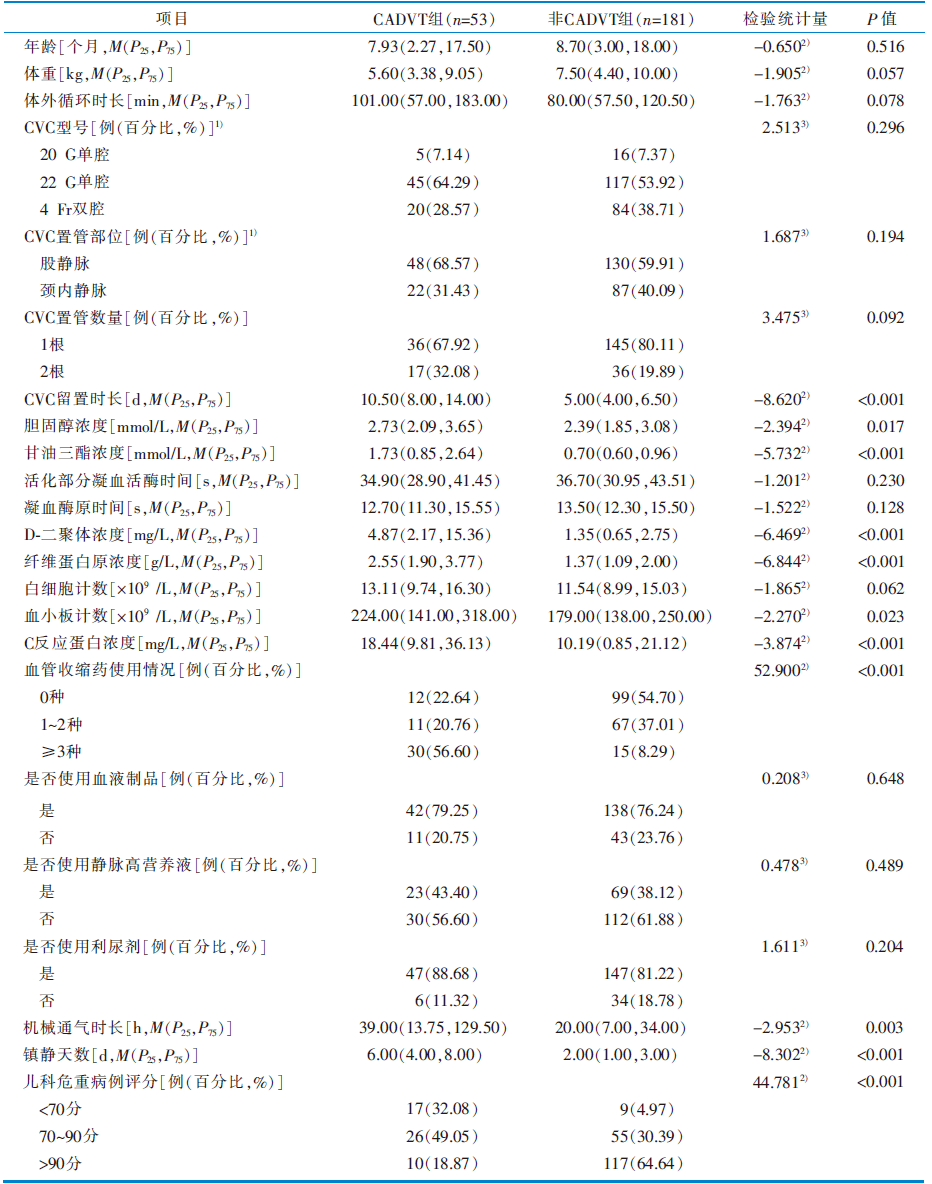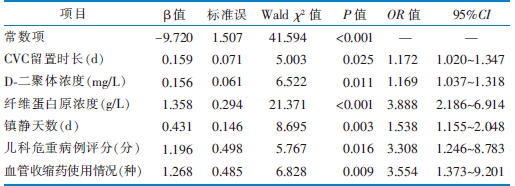


中华护理杂志 ›› 2022, Vol. 57 ›› Issue (18): 2217-2224.DOI: 10.3761/j.issn.0254-1769.2022.18.007
蒋伟红( ), 金陈娣, 李帅妮, 杨山凤, 严川川, 诸纪华(
), 金陈娣, 李帅妮, 杨山凤, 严川川, 诸纪华( )
)
收稿日期:2022-03-21
出版日期:2022-09-20
发布日期:2022-09-07
通讯作者:
诸纪华,E-mail: jihuazhu@zju.edu.cn作者简介:蒋伟红,女,本科(硕士在读),护师,E-mail: 847610762@qq.com
基金资助:
JIANG Weihong( ), JIN Chendi, LI Shuaini, YANG Shanfeng, YAN Chuanchuan, ZHU Jihua(
), JIN Chendi, LI Shuaini, YANG Shanfeng, YAN Chuanchuan, ZHU Jihua( )
)
Received:2022-03-21
Online:2022-09-20
Published:2022-09-07
摘要:
目的 构建先天性心脏病术后患儿中心静脉导管相关深静脉血栓(central venous catheter-associated deep venous thromboses,CADVT)风险预测模型,并验证该模型的预测效果。 方法 便利选取2021年1月—11月在浙江省某三级甲等儿童专科医院心脏外科监护室住院的234例患儿作为建模组,根据是否发生CADVT,将其分为CADVT组(53例)和非CADVT组(181例)。采用Logistic回归分析建立风险预测模型,采用Hosmer-Lemeshow检验判断模型的拟合优度,采用受试者操作特征曲线(receiver operator characteristic curve,ROC)检测模型的预测效果,并绘制列线图。选取2021年12月—2022年2月同一所医院收治的60例先天性心脏病术后患儿作为验证组,采用Hosmer-Lemeshow检验和ROC曲线对模型进行外部验证。 结果 先天性心脏病术后患儿CADVT发生率为22.65%。CVC留置时长(OR=1.172)、D-二聚体浓度(OR=1.169)、纤维蛋白原浓度(OR=3.888)、镇静天数(OR=1.538)、使用血管收缩药(OR=3.554)和儿科危重病例评分(OR=3.308)是其风险因素(P<0.05)。Hosmer-Lemeshow检验结果显示, χ2=4.456,P=0.814,ROC曲线下面积为0.957(95%CI:0.930~0.984),最佳临界值为0.813,灵敏度为0.962,特异度为0.851。外部验证结果显示,该模型的灵敏度为0.857,特异度为0.870,正确率为86.67%。 结论 该风险预测模型的预测效果良好,可为临床评估先天性心脏病术后患儿CADVT发生风险提供参考。
蒋伟红, 金陈娣, 李帅妮, 杨山凤, 严川川, 诸纪华. 先天性心脏病术后患儿中心静脉导管相关深静脉血栓风险预测模型的构建及验证[J]. 中华护理杂志, 2022, 57(18): 2217-2224.
JIANG Weihong, JIN Chendi, LI Shuaini, YANG Shanfeng, YAN Chuanchuan, ZHU Jihua. Construction and validation of a risk prediction model for central venous catheter-associated deep venous thromboses in children with congenital heart disease after surgery[J]. Chinese Journal of Nursing, 2022, 57(18): 2217-2224.
 |
表1 先天性心脏病术后患儿中心静脉导管相关深静脉血栓发生风险的单因素分析
Table 1 The result of single factor analysis of central venous catheter-associated deep venous thromboses in children with congenital heart disease after surgery
 |
 |
表2 先天性心脏病术后患儿中心静脉导管相关深静脉血栓发生风险的Logistic回归分析
Table 2 Logistic regression analysis of central venous catheter-associated deep venous thrombosis in children with congenital heart disease after surgery
 |

图1 先天性心脏病术后患儿中心静脉导管相关深静脉血栓风险预测列线图
Figure 1 A nomogram model for predicting central venous catheter-associated deep venous thrombosis in children with congenital heart disease after surgery

图2 建模组中心静脉导管相关深静脉血栓风险预测模型的受试者操作特征曲线
Figure 2 Receiver operating characteristic curve of the risk prediction model for central venous catheter-associa-ted deep venous thrombosis in the modeling group

图3 验证组中心静脉导管相关深静脉血栓风险预测模型的受试者操作特征曲线
Figure 3 Receiver operating characteristic curve of the risk prediction model for central venous catheter-asso-ciated deep venous thrombosis in the validation group
| [1] |
傅唯佳, 顾莺, 宓亚平, 等. 先天性心脏病术后延迟关胸患儿程序式喂养的护理[J]. 中华护理杂志, 2019, 54(7):1048-1051.
DOI |
| Fu WJ, Gu Y, Mi YP, et al. Nursing care of pediatric patients receiving procedural feeding with complicated congenital heart disease underwent delayed chest closure[J]. Chin J Nurs, 2019, 54(7):1048-1051. | |
| [2] |
Zhou XZ, Lin X, Shen RN, et al. A retrospective analysis of risk factors associated with catheter-related thrombosis:a single-center study[J]. Perfusion, 2020, 35(8):806-813.
DOI URL |
| [3] |
Li HM, Lu Y, Zeng X, et al. Prediction of central venous catheter-associated deep venous thrombosis in pediatric critical care settings[J]. BMC Med Inform Decis Mak, 2021, 21(1):332.
DOI URL |
| [4] |
Faustino EVS. Central venous catheter-associated deep venous thrombosis in critically ill children[J]. Semin Thromb Hemost, 2018, 44(1):52-56.
DOI PMID |
| [5] |
DiPietro LM, Gaies M, Banerjee M, et al. Central venous catheter utilization and complications in the pediatric cardiac ICU:a report from the pediatric cardiac critical care consortium (PC4)[J]. Pediatr Crit Care Med, 2020, 21(8):729-737.
DOI URL |
| [6] | Jaffray J, Young G. Deep vein thrombosis in pediatric patients[J]. Pediatr Blood Cancer, 2018, 65(3):1-9. |
| [7] |
Monagle P, Cuello CA, Augustine C, et al. American Society of Hematology 2018 guidelines for management of venous thromboembolism:treatment of pediatric venous thromboembolism[J]. Blood Adv, 2018, 2(22):3292-3316.
DOI PMID |
| [8] | 王宁, 郭振江, 张媛媛, 等. 危重症患者中心静脉导管相关性血栓危险因素分析及列线图预测模型的建立[J]. 中华危重病急救医学, 2021, 33(9):1047-1051. |
| Wang N, Guo ZJ, Zhang YY, et al. Risk factors analysis of central venous catheter-related thrombosis in critically ill patients and development of nomogram prediction model[J]. Chin Crit Care Med, 2021, 33(9):1047-1051. | |
| [9] | 张丹. 血液净化患儿深静脉血栓形成风险预测模型的构建[D]. 长春: 吉林大学, 2021. |
| Zhang D. Construction of risk prediction model of deep vein thrombosis in children with blood purification[D]. Changchun: Jilin University, 2021. | |
| [10] |
Marquez A, Shabanova V, Faustino EV, et al. Prediction of catheter-associated thrombosis in critically ill children[J]. Pediatr Crit Care Med, 2016, 17(11):e521-e528.
DOI URL |
| [11] |
刘莺歌, 吴燕, 曹秋君, 等. 肠造口周围潮湿相关性皮肤损伤风险预测模型的构建及应用[J]. 中华护理杂志, 2021, 56(11):1612-1617.
DOI |
| Liu YG, Wu Y, Cao QJ, et al. The development and validation of a risk prediction model for peristomal moisture-associated skin damage[J]. Chin J Nurs, 2021, 56(11):1612-1617. | |
| [12] | 冯瑞梅. 子宫颈癌与高危型人乳头瘤病毒感染的危险因素研究及风险预测模型构建[D]. 北京: 北京协和医学院, 2017. |
| Feng RM. Risk factors exploration of high-risk human papillomavirus infection and cervical cancer and development of risk prediction models[D]. Beijing: Peking Union Medical College, 2017. | |
| [13] | 郭玮, 何煜婷, 邵琦, 等. 联合血降钙素原、脑钠肽、D-二聚体及PCIS评分对评估儿童重症肺炎预后的价值[J]. 临床儿科杂志, 2017, 35(8):575-579. |
| Guo W, He YT, Shao Q, et al. Value of combining PCT,BNP,D-dimer and PCIS score in predicting the prognosis of severe pediatric pneumonia[J]. J Clin Pediatr, 2017, 35(8):575-579. | |
| [14] |
Silvey M, Brandão LR. Risk factors,prophylaxis,and treatment of venous thromboembolism in congenital heart disease patients[J]. Front Pediatr, 2017, 5:146.
DOI URL |
| [15] |
Steen EH, Lasa JJ, Nguyen TC, et al. Central venous catheter-related deep vein thrombosis in the pediatric cardiac intensive care unit[J]. J Surg Res, 2019, 241:149-159.
DOI URL |
| [16] |
Kerris EWJ, Sharron M, Zurakowski D, et al. Hospital-associated venous thromboembolism in a pediatric cardiac ICU:a multivariable predictive algorithm to identify children at high risk[J]. Pediatr Crit Care Med, 2020, 21(6):e362-e368.
DOI URL |
| [17] | 吴开元, 李斌, 华影, 等. 先天性心脏病婴幼儿术后下肢静脉血栓形成的高危因素分析[J]. 中华实用儿科临床杂志, 2020, 35(5):375-378. |
| Wu KY, Li B, Hua Y, et al. Analysis of risk factors of lower extremity venous thrombosis in pediatric patients after surgery for congenital heart disease[J]. Chin J Appl Clin Pediatr, 2020, 35(5):375-378. | |
| [18] |
Sartori M, Favaretto E, Cosmi B. Relevance of immobility as a risk factor for symptomatic proximal and isolated distal deep vein thrombosis in acutely ill medical inpatients[J]. Vasc Med, 2021, 26(5):542-548.
DOI URL |
| [19] | 杨晓佳. 2021例下肢深静脉血栓形成的临床回顾性分析[D]. 张家口: 河北北方学院, 2018. |
| Yang XJ. Retrospective analysis of 2021 cases of deep vein thrombosis of lower extremities[D]. Zhangjiakou: Hebei North University, 2018. | |
| [20] |
丁亚平, 诸纪华, 周红琴, 等. 每日唤醒应用于机械通气镇静患儿的研究进展[J]. 中华护理杂志, 2020, 55(10):1583-1587.
DOI |
| Ding YP, Zhu JH, Zhou HQ, et al. Research progress on daily interruption of sedation on children with mechanical ventilation[J]. Chin J Nurs, 2020, 55(10):1583-1587. | |
| [21] | 任洁, 熊小雨, 刘成军, 等. 先天性心脏病术后患儿血管活性药物评分与其预后关系[J]. 中华胸心血管外科杂志, 2018, 34(3):139-143. |
| Ren J, Xiong XY, Liu CJ, et al. Vasoactive-inotropic score as a predictor of outcome in children after cardiac surgery with bypass[J]. Chin J Thorac Cardiovasc Surg, 2018, 34(3):139-143. | |
| [22] |
Reynolds PM, van Matre ET, Wright GC, et al. Evaluation of prophylactic heparin dosage strategies and risk factors for venous thromboembolism in the critically ill patient[J]. Pharmacotherapy, 2019, 39(3):232-241.
DOI |
| [23] |
Bachi K, Mani V, Jeyachandran D, et al. Vascular disease in cocaine addiction[J]. Atherosclerosis, 2017, 262:154-162.
DOI URL |
| [24] |
Dörffler-Melly J, de Jonge E, Pont AC, et al. Bioavailability of subcutaneous low-molecular-weight heparin to patients on vasopressors[J]. Lancet, 2002, 359(9309):849-850.
PMID |
| [25] |
李海燕, 李蓉, 植艳茹, 等. 中老年患者院内发生静脉血栓栓塞症风险预测模型的研究[J]. 中华护理杂志, 2020, 55(1):68-73.
DOI |
| Li HY, Li R, Zhi YR, et al. Study on risk prediction model of in-hospital venous thromboembolism in middle-aged and elderly patients[J]. Chin J Nurs, 2020, 55(1):68-73. | |
| [26] | 胡书生, 王旭, 杨瑞芳, 等. D-二聚体和纤维蛋白原联合检测对恶性肿瘤合并深静脉血栓的诊断价值[J]. 国际生物医学工程杂志, 2019, 42(5):388-392. |
| Hu SS, Wang X, Yang RF, et al. Diagnostic value of combined detection of D-dimer and fibrinogen for malignant tumor with deep vein thrombosis[J]. Int J Biomed Eng, 2019, 42(5):388-392. | |
| [27] | 王文超, 王颖雯, 康琼芳, 等. 儿科中心静脉导管相关血栓发生的系统评价和Meta分析[J]. 中国循证儿科杂志, 2020, 15(6):419-425. |
| Wang WC, Wang YW, Kang QF, et al. Central venous access device-related thrombosis in pediatric patients:a systematic review and meta-analysis[J]. Chin J Evid Based Pediatr, 2020, 15(6):419-425. | |
| [28] | 步宏, 李一雷. 病理学[M]. 9版. 北京: 人民卫生出版社, 2018. |
| Bu H, Li YL. Pathology[M]. 9th ed. Beijing: People’s Medical Publishing House, 2018. | |
| [29] | 马力, 刘运江, 刘荫华. 中国乳腺癌中心静脉血管通路临床实践指南(2022版)[J]. 中国实用外科杂志, 2022, 42(2):151-158. |
| Ma L, Liu YJ, Liu YH. Clinical practice of Chinese guideline on central venous vascular access for breast cancer(2022 edition)[J]. Chin J Pract Surg, 2022, 42(2):151-158. |
| [1] | 成磊, 钱佳艺, 段明霞, 黄海英, 王颖雯. 专业照护者感知的癌症患儿向成人过渡影响因素的质性研究[J]. 中华护理杂志, 2022, 57(9): 1048-1053. |
| [2] | 李静, 侯云霞, 强万敏. 癌症患者非计划性再入院风险预测模型的范围综述[J]. 中华护理杂志, 2022, 57(9): 1079-1087. |
| [3] | 刘美华, 彭剑雄, 罗翠, 郑焱, 朱丽辉, 肖政辉, 张新萍, 李庆博, 熊亮. 机械通气患儿早期活动方案的构建及应用研究[J]. 中华护理杂志, 2022, 57(8): 901-907. |
| [4] | 李雪苹, 王磊, 张淮, 邢爱珍, 陈朝红, 尹志勤. Stanford A型主动脉夹层患者术后谵妄风险预测评分模型的构建与效果验证[J]. 中华护理杂志, 2022, 57(8): 950-957. |
| [5] | 徐园, 吴欣娟, 杨旭, 王钰, 庞冬, 王晓杰, 刘佳, 尚高鹏, 姜英, 朱丽筠, 马玉芬. 护士应用预防关节置换术后深静脉血栓形成最佳证据的障碍因素研究[J]. 中华护理杂志, 2022, 57(8): 958-963. |
| [6] | 岳岚, 许妍, 李珍, 杨长永, 古钰君, 王梦, 李蕾蕾. 肿瘤患者医用粘胶相关性皮肤损伤风险评估量表的编制及信效度检验[J]. 中华护理杂志, 2022, 57(8): 964-969. |
| [7] | 孙丽, 胡成文, 刘群慧, 方敏, 顾道琴, 许宝惠. 1例急性白血病患儿的安宁疗护实践[J]. 中华护理杂志, 2022, 57(8): 992-995. |
| [8] | 傅来建, 卢芳燕. 1例肝移植术后肺部卡氏肺孢子感染并发颅内出血患儿的护理[J]. 中华护理杂志, 2022, 57(8): 996-1000. |
| [9] | 张娟, 何娇, 罗黎, 张岚, 韩燕红. 新生儿医用粘胶相关性皮肤损伤预防及管理的最佳证据总结[J]. 中华护理杂志, 2022, 57(8): 1008-1012. |
| [10] | 赵丽华, 万兴丽, 朱友菊, 蒲倩婷, 胡艳玲, 史泽瑶, 刘玉兰, 陈晓娟, 付丽. NICU早产儿基于行为线索的经口喂养模式的研究进展[J]. 中华护理杂志, 2022, 57(8): 1013-1018. |
| [11] | 黄勤, 张晓波, 顾莺, 胡静, 孔梅婧, 傅唯佳. 儿童静脉输液过程质量监控数据表的构建及应用[J]. 中华护理杂志, 2022, 57(7): 823-826. |
| [12] | 施若霖, 张丽青, 孙捷豪, 翁成杰, 郭城楠, 孙彩霞, 潘贻飞, 谢作流, 王明山, 卢中秋. 间歇充气加压装置不同使用模式对预防直肠癌腹腔镜术中患者静脉血栓的效果[J]. 中华护理杂志, 2022, 57(6): 695-702. |
| [13] | 余群飞, 张玉萍, 任英, 许国萍, 马姚静, 赵腾飞. 1例Ⅲ型戈谢病伴重度脊柱后凸畸形患儿的围手术期护理[J]. 中华护理杂志, 2022, 57(6): 736-739. |
| [14] | 赵林芳, 蔡志云, 樊小朋, 姜凤娅, 赵磊, 赵锐祎. 中等长度静脉导管置管不同尖端位置的效果比较[J]. 中华护理杂志, 2022, 57(5): 517-524. |
| [15] | 王刚, 潘月帅, 孟艳雷, 林辉, 王蕊, 万香玉, 魏丽丽. ICU患者血液净化专用中心静脉导管封管情况的调查[J]. 中华护理杂志, 2022, 57(5): 525-531. |
| 阅读次数 | ||||||
|
全文 |
|
|||||
|
摘要 |
|
|||||